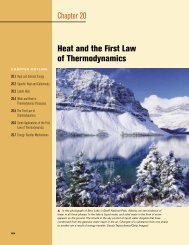15 • Oscillatory Motion - ECHSPhysics
15 • Oscillatory Motion - ECHSPhysics
15 • Oscillatory Motion - ECHSPhysics
You also want an ePaper? Increase the reach of your titles
YUMPU automatically turns print PDFs into web optimized ePapers that Google loves.
<strong>15</strong>.6 Damped Oscillations<br />
The oscillatory motions we have considered so far have been for ideal systems—that is,<br />
systems that oscillate indefinitely under the action of only one force—a linear restoring<br />
force. In many real systems, nonconservative forces, such as friction, retard the motion.<br />
Consequently, the mechanical energy of the system diminishes in time, and the motion<br />
is said to be damped. Figure <strong>15</strong>.21 depicts one such system: an object attached to a<br />
spring and submersed in a viscous liquid.<br />
One common type of retarding force is the one discussed in Section 6.4, where the<br />
force is proportional to the speed of the moving object and acts in the direction opposite<br />
the motion. This retarding force is often observed when an object moves through<br />
air, for instance. Because the retarding force can be expressed as R b v (where b is<br />
a constant called the damping coefficient) and the restoring force of the system is kx,<br />
we can write Newton’s second law as<br />
kx b<br />
F x kx bv x ma x<br />
(<strong>15</strong>.31)<br />
The solution of this equation requires mathematics that may not be familiar to you;<br />
we simply state it here without proof. When the retarding force is small compared<br />
with the maximum restoring force—that is, when b is small—the solution to Equation<br />
<strong>15</strong>.31 is<br />
where the angular frequency of oscillation is<br />
b m 2m 2<br />
dx<br />
dt<br />
m<br />
b<br />
<br />
x Ae 2m t cos(t )<br />
√ k<br />
(<strong>15</strong>.32)<br />
(<strong>15</strong>.33)<br />
This result can be verified by substituting Equation <strong>15</strong>.32 into Equation <strong>15</strong>.31.<br />
Figure <strong>15</strong>.22 shows the position as a function of time for an object oscillating in the<br />
presence of a retarding force. We see that when the retarding force is small, the oscillatory<br />
character of the motion is preserved but the amplitude decreases in<br />
time, with the result that the motion ultimately ceases. Any system that behaves in<br />
this way is known as a damped oscillator. The dashed blue lines in Figure <strong>15</strong>.22,<br />
which define the envelope of the oscillatory curve, represent the exponential factor in<br />
Equation <strong>15</strong>.32. This envelope shows that the amplitude decays exponentially with<br />
time. For motion with a given spring constant and object mass, the oscillations<br />
dampen more rapidly as the maximum value of the retarding force approaches the<br />
maximum value of the restoring force.<br />
It is convenient to express the angular frequency (Eq. <strong>15</strong>.33) of a damped oscillator<br />
in the form<br />
√ 0<br />
2 b<br />
2m 2<br />
where 0 √k/m represents the angular frequency in the absence of a retarding force<br />
(the undamped oscillator) and is called the natural frequency of the system.<br />
When the magnitude of the maximum retarding force Rmax bvmax kA, the system<br />
is said to be underdamped. The resulting motion is represented by the blue curve<br />
in Figure <strong>15</strong>.23. As the value of b increases, the amplitude of the oscillations decreases<br />
more and more rapidly. When b reaches a critical value bc such that bc/2m 0, the<br />
system does not oscillate and is said to be critically damped. In this case the system,<br />
once released from rest at some nonequilibrium position, approaches but does not<br />
pass through the equilibrium position. The graph of position versus time for this case<br />
is the red curve in Figure <strong>15</strong>.23.<br />
d 2 x<br />
dt 2<br />
SECTION <strong>15</strong>.6 <strong>•</strong> Damped Oscillations 471<br />
m<br />
Figure <strong>15</strong>.21 One example of a<br />
damped oscillator is an object<br />
attached to a spring and submersed<br />
in a viscous liquid.<br />
A<br />
x<br />
b<br />
– t<br />
2m<br />
Ae<br />
0 t<br />
Active Figure <strong>15</strong>.22 Graph of<br />
position versus time for a damped<br />
oscillator. Note the decrease in<br />
amplitude with time.<br />
At the Active Figures link<br />
at http://www.pse6.com, you<br />
can adjust the spring constant,<br />
the mass of the object, and the<br />
damping constant and see the<br />
resulting damped oscillation of<br />
the object.<br />
x<br />
a<br />
b<br />
Figure <strong>15</strong>.23 Graphs of position<br />
versus time for (a) an<br />
underdamped oscillator, (b) a<br />
critically damped oscillator, and<br />
(c) an overdamped oscillator.<br />
c<br />
t



